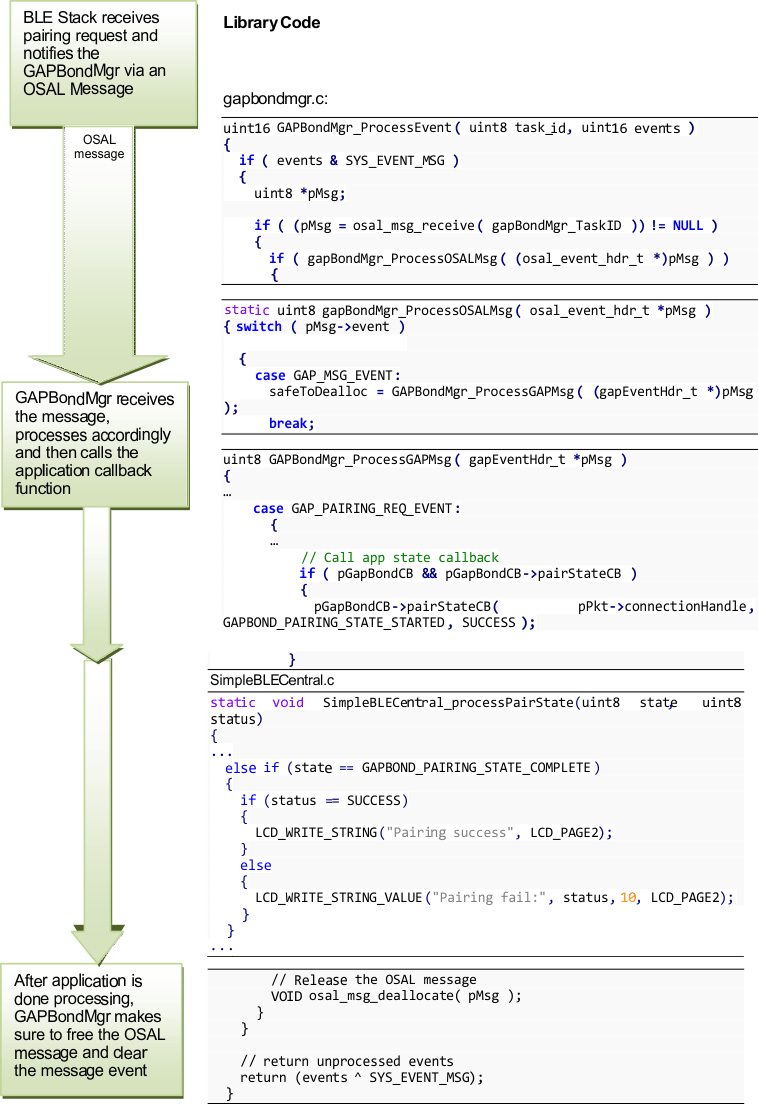SWRU271I October 2010 – January 2020 CC2540 , CC2540T , CC2541 , CC2541-Q1 , CC2640R2F
- Preface
- 1Overview
- 2The TI Bluetooth Low Energy Software Development Platform
- 3The Operating System Abstraction Layer (OSAL)
- 4The Application and Profiles
-
5The Bluetooth Low Energy Protocol Stack
- 5.1 Overview
- 5.2 Generic Access Profile (GAP)
- 5.3 GAPRole Task
- 5.4 Gap Bond Manager (GAPBondMgr)
- 5.5
Generic Attribute Profile (GATT)
- 5.5.1 GATT Characteristics and Attributes
- 5.5.2 GATT Services and Profile
- 5.5.3 GATT Client Abstraction
- 5.5.4 GATT Server Abstraction
- 5.6 L2CAP
- 5.7 HCI
- 5.8 Library Files
- 6Drivers
- 7Creating a Custom Bluetooth Low Energy Application
- 8Development and Debugging
-
9General Information
- 9.1 Overview
- 9.2 Porting From BLE-Stack 1.5.0 to 1.5.1
- 9.3 Porting From BLE-Stack 1.4.2 to 1.5.0
- 9.4
Porting From Earlier BLE-Stack Versions
- 9.4.1 Porting BLEv1.4.1 Projects to BLEv1.4.2
- 9.4.2 Porting BLEv1.4.0 Projects to BLEv1.4.1
- 9.4.3 Porting BLEv1.3.2 Projects to BLEv1.4.0
- 9.4.4 Porting BLEv1.2 Projects to BLEv1.3
- 9.4.5 Porting From CC2540 to CC2541 Project
- 9.5 Release Notes History
- 9.6 Document History
- A GAP API
- B GAPRole Peripheral Role API
- C GAPRole Central Role API
- D GATT/ATT API
- E GATTServApp API
- F GAPBondMgr API
- G HCI Extension API
- Revision History
5.4.2 Using the GapBondMgr Profile
The GAPBondMgr implements most of the functions in the overview. This section describes what the application must do to configure, start, and use the GAPBondMgr. The GAPRole also handles some of the functionality of the GAPBondMgr. The GAPBondMgr is defined in gapbondmgr.c. gapbondmgr.h. describes the API including commands, configurable parameters, events, and callbacks. The steps to use this module are as follows. The SimpleBLECentral project is the example because it uses the callback functions from the GAPBondMgr.
- Initialize the GAPBondMgr parameters. Do this in the application initialization function (that is, SimpleBLECentral_init()). Consider the following parameters. For the example, the pairMode has been changed to initiate pairing.
- Register application callbacks with the GAPBondMgr. Do this registration after the GAPRole starts in the START_DEVICE_EVT processing:



The GAPBondMgr is configured and operates autonomously. When a connection is established, the GAPBondMgr initiates pairing and bonding depending on the configuration parameters from Step 1. You can set a few parameters asynchronously such as GAPBOND_ERASE_ALLBONDS. All communication between the GAPBondMgr and the application occurs through the callbacks that were registered in Step 2. The following is a flow diagram example from SimpleBLECentral of the GAPBondMgr, notifying the application that pairing has started. The following sections expand on these callbacks.
